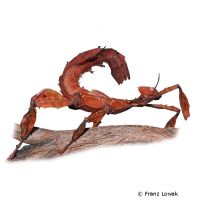Giant Prickly Stick Insect (Extatosoma tiaratum)
| Giant Prickly Stick Insect Extatosoma tiaratum | |
|---|---|
| Name | Giant Prickly Stick Insect |
| Name Lat. | Extatosoma tiaratum |
| Family | Walking Sticks |
| Family lat. | Phasmatidae |
| Order | Phasmids |
| Order lat. | Phasmatodea |
| Origin | Australia |
| Habitat | Forest |
| Diet | Eucalyptus, rose-family leaves |
| Humidity | 60-70 % |
| Behavior | Nocturnal, peaceful |
| Keeping | Individual, pair, group |
| Care Level | Easy |
| Housing | Semi-humid terrarium |
| Breeding | Moderately difficult |
| Life Span | 6-12 months |
| Protection | No |
| Metric Units | |
| Size | 9-14 cm |
| Temperature Day | 25-30 °C |
| Temperature Night | 20-25 °C |
| Housing Size | 50 x 50 x 60 cm |
| US Units | |
| Size | 3.5"-5.5" |
| Temperature Day | 77-86 °F |
| Temperature Night | 68-77 °F |
| Housing Size | 20" x 20" x 25" |
Distribution and habitat
Predominantly nocturnal, Australian ghost insects are found throughout much of Queensland, northeastern Australia, and New Guinea. They inhabit trees and shrubs in tropical forests, but are not bound to any particular habitat. Their coloration can vary from greenish to yellow to brown in adults.
Maintenance
A terrarium of L 50 x W 50 x H 60 cm for up to 6 animals is recommended. The terrarium should be placed in a quiet place without sunlight. Terrariums with a cover made of gauze or fine metal mesh are recommended.
They need climbing facilities, like cork back walls as well as twigs and branches, which also serve as food plants and a narrow-necked, stable water container (e.g. vase) for the food plants. Suitable substrate is terrarium humus or a soil-sand mixture covered with moss, which should always be kept slightly moist. The terrarium should be finely sprayed with water (humidity) once a day, preferably in the evening inside, but a rain or mist system is better. Waterlogging is to be avoided at all costs.
| Temp. day: 25-30 °C | Temp. night: 20-25 °C | Humidity: 60-70 |
Although the animals are nocturnal, a light source that also produces the necessary heat is ideal. The lighting duration should be 8-12 hours, depending on the season.
Diet
In nature, they feed mainly on eucalyptus leaves. Also fresh leaves of roses and rose plants, such as red and hawthorn, blackberry and raspberry, as well as leaves of beech, oak lime, hazel or sweet chestnut are accepted individually different. Blackberries are ideal as forage in winter because they remain green. By spraying the forage plants, the animals can satisfy their drinking needs. In addition, a wick waterer is recommended. Eaten branches must be replaced regularly
A varied diet promotes the well-being of the animals.
Reproduction and breeding
The males are slightly smaller, slimmer and can fly. The females, on the other hand, have reduced wings and cannot fly, are more massive, have a body covered with spines and leaf-shaped appendages of the limbs
They can reproduce sexually or asexually by virgin reproduction (parthenogenesis). This produces offspring from unfertilized eggs. The hatching rate is greater in sexual reproduction. One female can lay over 100 eggs, which are simply dropped on the ground. The incubation period is 2-7 months at 22-28 °C. The newly hatched dark brown to black young, with a white collar and bright red head, resemble a very defensible ant species (ant mimicry). Generally, the number of male offspring is lower. After the last molt, females live up to 12 months, males up to 6 months
Important
For molting, they hang upside down in the branches or on the lattice cover and slide out of their old shell. Therefore, they need at least one body length of free space below them.
When handling females, they may use their hind legs like jackknives to defend themselves. With their camouflage costume, they adapt to their surroundings, making it difficult for their predators to detect them (mimesis).
Before buying a terrarium should be prepared, which corresponds to the species-specific needs. Good ventilation without drafts is necessary, as well as equipment for measuring temperature and humidity. The lighting has to correspond to the species-specific day-night rhythm and has to be installed in such a way that the animals cannot injure themselves
The terrarium should be locked in such a way that neither unauthorized persons can open it nor the animals can escape. Special attention must be paid to thorough hygiene and impurities must be removed regularly
Further literature can be found in your pet store
References
Text: Nina Leitner; Image: Franz Lowak
Source: SEILER, BRADLER, KOCH (2000): Ratgeber Phasmiden, Verlag Bede; HENKEL & SCHMIDT (2010): Taschenatlas Wirbellose für das Terrarium, Verlag Ulmer; ENGELMANN & LANGE (2011): Zootierhaltung - Tiere in menschlicher Obhut: Wirbellose, Harri Deutsch Verlag
